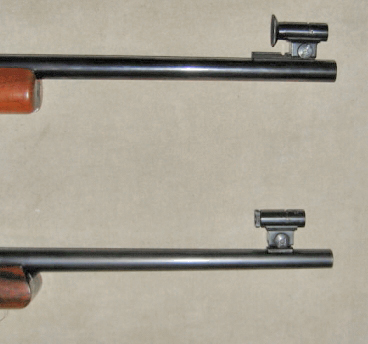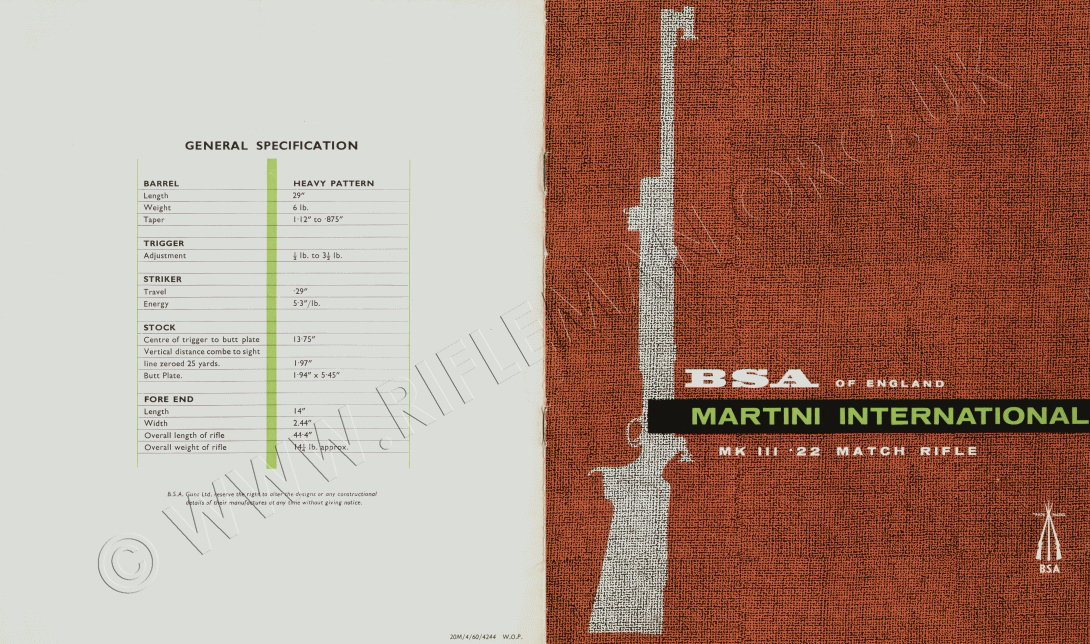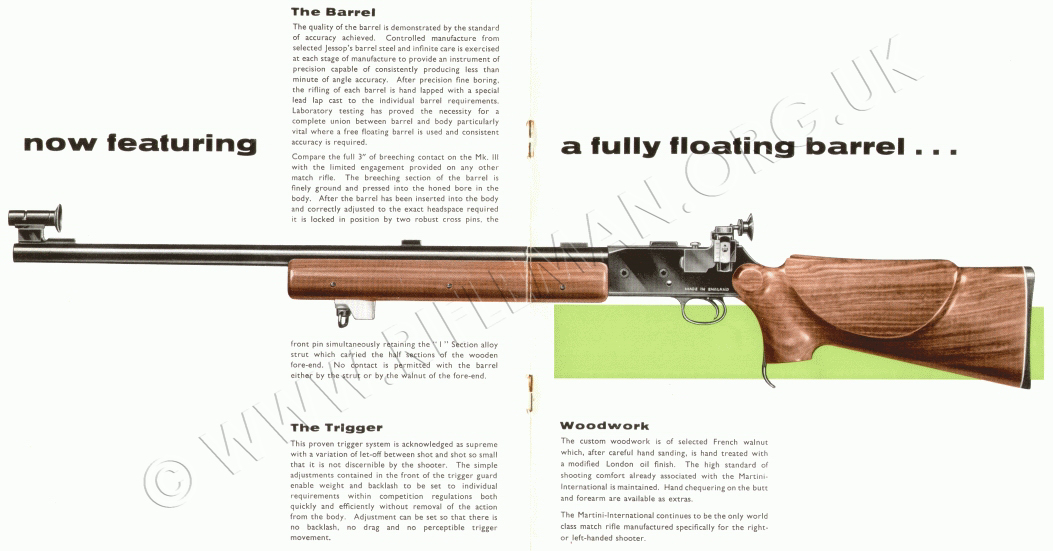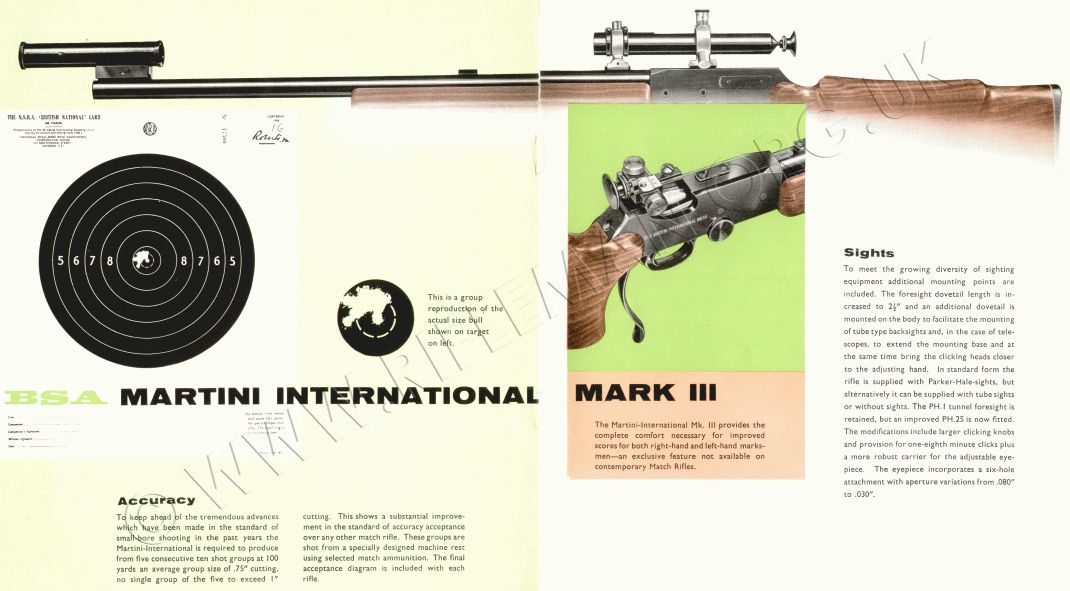The BSA MARTINI INTERNATIONAL Mark III
.22RF MATCH RIFLE
This page includes drawings and the manualSee also the BSA Martini International Mk.I & II and the BSA Martini Internationals Mks. IV & V
or: ......ENFIELD TRAINING RIFLES ...... - ......SMALL-BORE TARGET RIFLES
Below is an image of the second (serial no. P2 ) of the five prototype rifles
made for the Mk.III InternationalThe rifle in the 3D image below can be rotated through both axes by dragging your cursor left to right.
It can be zoomed and panned by clicking with the magnifier, and viewed full screen using the arrows top right.
These rifles were probably designed in the very late 1950s and built and tested in 1959 to 1960, since the production model was announced early in 1961 after considerable modification, as related on this page.
This particular rifle was subsequently used by the late John Hall - a well known International small-bore shot
and longstanding staff member of the Eley ammunition company.
The combination was instrumental in his winning the Lord Roberts Trophy in 1963
and selection for the team which went to the Tokyo Olympic games in 1964.
This rifle was indeed taken to Tokyo and used in those events.
A further image of the same rifle later fitted with a Redfield target 'scope for "any sights" competition.
( The fore-sight would be removed before shooting)
The prototype rifles, the first Internationals with fully-floating barrels, employed a steel under-barrel hanger,
rivetted into the front of the action, which supported the fore-end furniture
clear of the barrel for its entire length.
The hanger also needed to be strong enough to counter the load applied
by the single-point rifle sling, by now in common use.
The substantial steel hanger of the prototypes proved far too heavy for normal usage.
It was replaced in production by an aluminium alternative,
the spur of which clamped into the action below the barrel. More of this anon.
To the left is an image illustrating
the prototype and production
hanger arrangements.
The steel prototype is on the left,
and the aluminium
production item on the right.
In an attempt to counter the
excessive weight at the
front of the rifle, the barrel
was tapered on the prototypes.
The lighter production rifles
reverted to the parallel barrels
hitherto familiar to owners of Marks I and II rifles.
Top: - production barrel; Bottom: prototype barrel
On the tapered barrel, a higher foresight block was needed to bring the tunnel to the correct height
In the image to the left, the upper action is that
of the prototype. The two central flush rivets
clamping the barrel and hanger into the action
are just visible; a third rivet, low down just
forward of the trigger guard assembly, is not here
visible. The end of the action locating pin can be
clearly seen. A glance at the views below of the
RHS of both actions will clarify the point.
The fore-end woodwork of the prototype was
faired neatly back into the action along the lines
of previous marks. This aesthetically pleasing
feature was omitted from the production model of
the Mk.III and from all subsequent models -
probably on the basis of cost.
The third rivet is just about discernible at the
bottom right-hand corner of the action side-
plate of the prototype rifle - the lower rifle in
this image. The large knurled head of the
screw-in action locking pin is evident in the
same position on both actions.
The prototype rifle is fitted with 'scope
mounting blocks only on the barrel.
This production rifle has
an additional block above the action.
The next image below is taken
from below the two actions.
The differences in shaping to the front of the
action are quite apparent, as is the way in
which the two hangers are clamped into the
respective actions.
The production rifle, much heralded replacement for the Mark II,
was announced in the shooting press in theSpring of 1961.
Below: the production model of the Mk.III International rifle.
Drag horizontally to rotate subject - Click to zoom and drag to pan - Full screen viewing from <- ->
The rifle was advertised in the Parker-Hale catalogue of 1962 at a price,
without sights, of £56-0s-0d. With the Parker-Hale No.25C sights which became the standard,
the cost was £65-0s-0d and with the Freeland tube sights the price rocketed to £80-0s-0d.
Contemporary rifles, such as the Finnish Lion and the Anschutz Model 54 Super Match,
were then priced at £65-0s-0d and £89-15s-0d respectively.

A good International will shoot every bit as well as an Anschutz of much lesser age.
A colleague was still using his Mk.III in County competition with a high degree of success in the late 1990s.
The Mk.III has a fully floating barrel, but the main consideration with these is the aluminium hanger
to which the fore-end is fixed.
Where this is clamped into the action body below the barrel there is a risk of movement
if the aluminium has been bent or damaged, or if the clamping screws have been incorrectly tightened.
Replacement hangers are almost impossible to find.
A good Mk.III will perform as well as any if the hanger is in perfect trim.
With the later Internationals, there had developed a general feeling that they
are "unforgiving" of indifferent position, hold or technique; particularly also trigger pull -
- but that is true of almost any firearm.
However, master these aspects and you will not be disappointed.
We have Mk.I to Mk.III rifles being shot, in the Post-Veteran class of our historic leagues,
at a level which many modern Anschutz users would be pleased to match.
If you were to make a one-piece stock including the fore-end and thereby obtain a fully floating barrel
with the sling attachment solely on the furniture, then you would have produced a formidable rifle.
BSA should perhaps have done this themselves. Also, the fact that BSA did not provide the customising
accessories with their rifles, such as were on offer from other European manufacturers,
was no doubt a factor in poor sales in the final years.
Additionally, whilst the Marks IV and V were re-tooled, the configuration was, for all practical purposes,
returned to that of the Marks I and II rather than progressing beyond the Mark III.
One might suspect that this did not help very much, particularly at a time when Anschutz
and their contemporaries were significantly updating their rifles aesthetically as well as technically.
It could today be argued that modern fashion trends are selling rifles more than technical advances in design.
One of the .22RF Jurek Target Rifles designed and built by Dr. M.K. Jurek in, we believe,
the late fifties has recently achieved a score of 97 ex 100 on the current 1988 NSRA target .
The rifle came with a thumbhole stock and adjustable hook butt-plate from day one -
- as did the Finnish Lion and other equivalent models of the time.
BSA produced some of the best barrels of the day, fine Martini actions and excellent triggers,
but were left behind in many other respects. Very sad.
An International is still the rifle to use for any timed competition, e.g. the Queen Alexandra second stage.
what should perhaps have been expanded upon in the preceding paragraphs
is the fact that the problem with the Mark III,
in respect of the aluminium fore-end hanger, was probably what most damaged theInternational's reputation.
The Marks IV and V were not wholly successful attempts made toward the recovery of that reputation.
The prototype Mk.III rifles had steel fore-end hangers which were quite satisfactory in all respects except weight.
These were very heavy rifles that would have been unacceptable to rifle shooters at large.
The alloy replacement for the production rifles caused problems because it was easily bent
or damaged if the rifle fell over from a rack, for instance.
The clamping of both the hanger and barrel in the action body could then be affected.
The torque applied to the clamping bolts was critical and,
because the bolts were centrally placed between the steel barrel and the alloy hanger,
the same clamping force was applied to dissimilar metals.
The alloy, being more ductile than the steel, could eventually become more loosely held
than the barrel and affect the whole setup. In the subsequent models, the Mark IV, ISU and Mark V,
the reversion to only the barrel being clamped into the action body cured this,
but was not sufficient of an advance to restore anything
other than the status quo achieved by the very successful Mk.II.
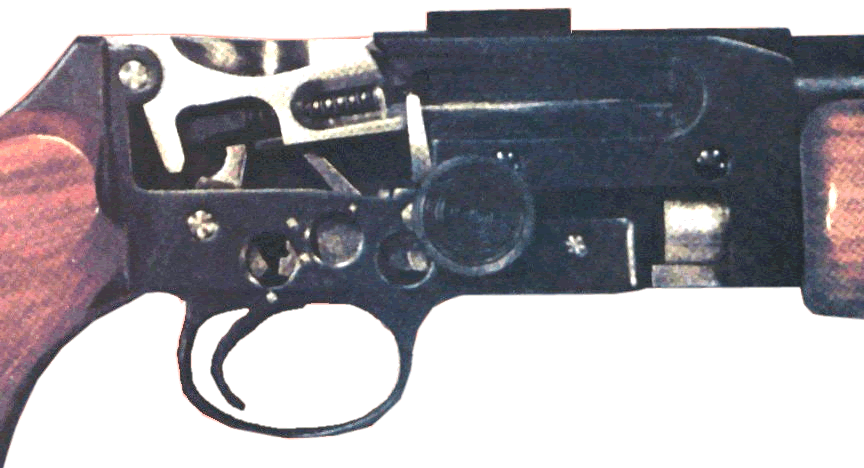
The brochure published by BSA at the time is represented below
- the zoomable text is just about legible.
This double page illustrated the rifle fitted with the Freeland tube sight system
- an expensive option for the day.
Images of the system are shown below.
The Freeland tube sight, by Al Freeland of Rock Island, Illinois,
was a popular optional extra in the mid 1960s.
As will have been understood, if the page on the original BSA Martini International has been first viewed,
Al Freeland was responsible for the design of the stocking of that rifle.
With the associated tunnel fore-sight,
the Freeland system became a well-
respected sighting arrangement, although
many shooters felt that the pivoting of the
rear-sight tube for elevation and windage
adjustment, similar to that much utilised
on telescopic sights of the day,
caused problems in sight-line not exhibited by traditional aperture sights such as the PH 25 model
which was standard issue with the International rifles.
It was really a case of each to his own!
The idea was of sufficient interest in the U.K. for a British Champion shot, the late Andrew St.G. Tucker
- best known for his range of shooting jackets,
to arrange for the manufacture of his own tube-sight system, illustrated below.
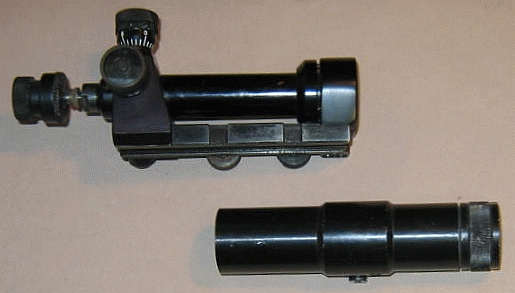
The National Small-bore Rifle Association hold, in their collection, a sectioned Mark III International
made by the Birmingham Small Arms Co. for publicity purposes.
The fore-end hanger can clearly be seen where the fore-end woodwork has been cut back.
Two images of this are shown below, courtesy of the N.S.R.A.


Below is a reproduction of the pamphlet that came with each new Mk.III rifle
giving care and maintenance advice,
and a detailed cross-sectional drawing of the rifle with a notated parts listing.


The zoomable exploded drawing with parts list.
Also supplied with each new rifle was this folding card
relating to the Parker-Hale sights supplied as standard.
The Mk.III had an improved Model 25 rearsight with one-eighth minute clicks
instead of the one-quarter minute clicks of the Mk.I and Mk.II rifles' sights.

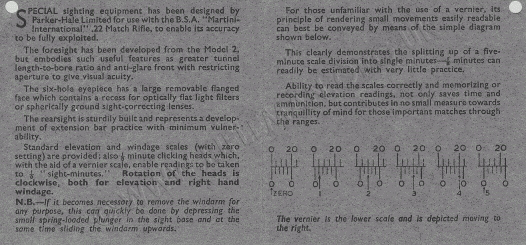
Each rifle came with a five group test card showing the 100 yard grouping of that barrel
and averaging the five groups to an overall group size - in this case 0.60 inches.
The best group was 0.4 inches and the worst 0.90 inches with 2 "fliers".
Nonetheless, groups of around a half inch at 100 yards
would still be competitive over forty years later.
The ammunition used was Eley's "Tenex" top match production.
Interestingly, the groups were fired onto a sighting diagram roll sheet
(Drg. Ref. No. S.A.I D1) originally used for a similar purpose,
but, printed for the S.M.L.E. ( Rifle, Short, Magazine Lee-Enfield ),
presumably from earlier days when the Birmingham Small Arms Company
was manufacturing these rifles and testing them with Mk.VII .303 centre fire ammunition.
The old saying "waste not, want not", much vaunted in the 1939-45 period, was obviously still in mind twenty years later.
A generation on, and one cannot help but feel that the advice may have been forgotten.
Only one of the five diagrams is illustrated of the 30 inch section supplied from the test range's continuous roll group testing target system.

B.S.A. aimed to manufacture their
International barrels to perform to a standard
better than a three-quarter-inch group at 100 yds.
The test group of 0.04 inches is
<<<< offset to the left on the target.
Centralising the group was evidently not considered particularly important.
Indeed, illustrating the excellent level of accuracy to the purchaser
was no doubt the overriding consideration.
Finally, not long after the introduction of the Martini International,
a requirement was found for a smaller lightweight version for ladies,
youngsters and other persons of small build.
These rifles were shorter in the butt-stock, and shorter and lighter in the barrel.
The Mark III was no exception. BSA manufactured both lightweight and left-handed versions of the rifle.
The example shown below exhibits both characteristics.
The barrel length is 26¾ inches as opposed to the 29 inches of the standard Mk.III rifle.

Below, the reduction in barrel diameter of the lightweight rifle can be seen just forward of the action,
where the standard barrel diameter remains protruding only about one-eighth of an inch.
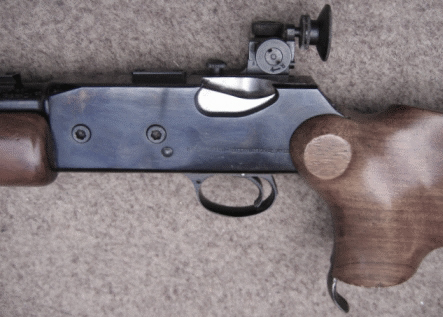
The markings are low on the rear quarter of the action body side:
"BSA MARTINI INTERNATIONAL Mk.III"
The serial number has a "U" prefix only.
The original Lightweight International rifles - of 1950-54 vintage - exhibit only an "F" prefix.

Above, the barrel diameter returns to standard just behind the foresight mounting block.
Otherwise a special block of increased height would have needed to be manufactured solely for these rifles.
As may already have been seen on the page for the Mk.II rifle, a Martini International's day is never done!
Not only are these rifles still regularly in use, in as-manufactured original form, for historic competition,
but they can be found metamorphosed into benchrest disciplines, as with the modified Mk.III shown below.

See: NSRA small-bore Benchrest competition information. (External link)
Or see the "bull-barrelled" Mk.V shown on the page for the Internationals Mks IV & V.
See also the BSA Martini International Mk.I & II
Are you seeking spares for your small-bore B.S.A. rifle?



